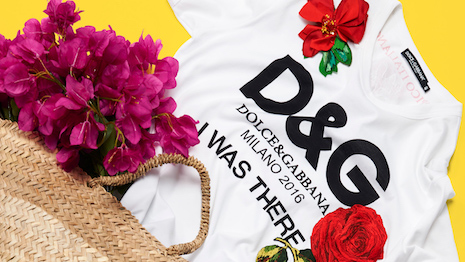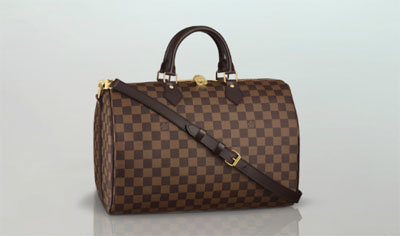 Dolce & Gabbana #DGTheRealFake tee leans into the skid
Dolce & Gabbana #DGTheRealFake tee leans into the skid
While more resources are becoming available to help consumers arm themselves with knowledge in the fight against counterfeits in fashion, it seems that fashion labels themselves are not free of blame.
A new report from Fashionbi shows that fashion brands themselves are being shown to copycat, with many stealing others’ designs and even including pieces from artists as patterns. As digital creates more venues for counterfeit operators to thrive, there was a 15 percent increase in fake goods sold online in the last year.
“It is not only the local crime cells/gangs selling the fake goods and deteriorating the fashion and luxury business but often the designers copy from each other, too,” said Ambika Zutshi, CEO of Fashionbi. “For instance, the famous lawsuit of Christian Louboutin against Saint Lauren't use of red sole in shoes or Ivanka Trump being sued of exactly copying Aquazzura’s strappy, fringed Wild Thing sandals.
“Also, fashion labels can put the exact graffiti or photography from other independent artists on their couture dresses without consent or due credit to the latter like in the case of Jeremy Scott sued by graffiti artist Rime, or that even the same segment brands copy from each other like in the case of mass market brands H&M & Forever 21's 'Beach Please' bag,” she said. “It is surprising how the 'copycats' think they can get away with it, or that no one will notice.”
Copycatters
The Business of Counterfeit Fashion showed that in Europe and the United States, jewelry and watches seem to be the most counterfeited products, followed by handbags and sunglasses. Many estimate that the counterfeit industry from shoes and clothing alone has reached $250 billion a year.
About 34 percent of Europeans enjoy saving money and sacrificing for a fake knockoff.
 Louis Vuitton Speedy 35 is often counterfeited
However, the problem does not just lie with fake reproductions but also with brands stealing from other brands and artists. For instance, Christian Louboutin claimed Cesare Paciotti and Saint Laurent encroached on its red sole trademark.
Also, Italian footwear label Aquazzura recently took Ivanka Trump to court, claiming copyright infringement.
Louis Vuitton Speedy 35 is often counterfeited
However, the problem does not just lie with fake reproductions but also with brands stealing from other brands and artists. For instance, Christian Louboutin claimed Cesare Paciotti and Saint Laurent encroached on its red sole trademark.
Also, Italian footwear label Aquazzura recently took Ivanka Trump to court, claiming copyright infringement.
 Aquazzura Christy flats
The brand filed a suit with the federal court in New York, centering its case on a sandal from the Ivanka Trump line that it says is nearly identical to its own Wild Thing style. According to a statement about its legal action, Aquazzura says it has eyed perceived copycat designs from Ivanka Trump consistently over the past two years (see more).
Counterfeitters
Another major battle has been the ready-to-wear brands Forever21 and H&M battle over a beach tote. The latter designing a tote with the words “beach, please” written with over scape of the sun setting around palm trees.
H&M filed suit against Forever21 claiming it exactly copied the design.
Amazon is continuing to grow and its penetration into the most affluent households has decreased over the past year, according to new research from the Shullman Research Center.
Luxury brands continue to ostracize the retailer, worried that its counterfeit goods and tendency to discount would hurt the brand too much to justify the revenue increases. Nevertheless, affluent classes’ growing affinity for the marketplace provides a provocative counterpoint arguing for its eventual integration into the luxury industry (see more).
“Fashionbi's latest research on analyzes the wholesome scenario of not only the gray business but also fashion plagiarism, parallel ecommerce and, most interestingly, the initiatives, technologies and softwares that are currently on the market to help customers detect the authenticity of a product they are buying,” Ms. Zutshi said. “A lot of government and private organisations have come up in fight against the counterfeit fashion business.
“For instance, International AntiCounterfeiting Coalition is one such state-level example and RFID chips installed in product tags can be taken as one of the private-level solutions,” she said. “In addition, many conglomerates like LVMH have belted up and created internal counterfeit policing, monitoring and combat departments for more efficient and accurate detections and faster solutions.
“Overall, the fakes business might never be 100 percent abolished but at least the brands can help consumers become smarter and help them invest in the real certified products.”
Aquazzura Christy flats
The brand filed a suit with the federal court in New York, centering its case on a sandal from the Ivanka Trump line that it says is nearly identical to its own Wild Thing style. According to a statement about its legal action, Aquazzura says it has eyed perceived copycat designs from Ivanka Trump consistently over the past two years (see more).
Counterfeitters
Another major battle has been the ready-to-wear brands Forever21 and H&M battle over a beach tote. The latter designing a tote with the words “beach, please” written with over scape of the sun setting around palm trees.
H&M filed suit against Forever21 claiming it exactly copied the design.
Amazon is continuing to grow and its penetration into the most affluent households has decreased over the past year, according to new research from the Shullman Research Center.
Luxury brands continue to ostracize the retailer, worried that its counterfeit goods and tendency to discount would hurt the brand too much to justify the revenue increases. Nevertheless, affluent classes’ growing affinity for the marketplace provides a provocative counterpoint arguing for its eventual integration into the luxury industry (see more).
“Fashionbi's latest research on analyzes the wholesome scenario of not only the gray business but also fashion plagiarism, parallel ecommerce and, most interestingly, the initiatives, technologies and softwares that are currently on the market to help customers detect the authenticity of a product they are buying,” Ms. Zutshi said. “A lot of government and private organisations have come up in fight against the counterfeit fashion business.
“For instance, International AntiCounterfeiting Coalition is one such state-level example and RFID chips installed in product tags can be taken as one of the private-level solutions,” she said. “In addition, many conglomerates like LVMH have belted up and created internal counterfeit policing, monitoring and combat departments for more efficient and accurate detections and faster solutions.
“Overall, the fakes business might never be 100 percent abolished but at least the brands can help consumers become smarter and help them invest in the real certified products.”
